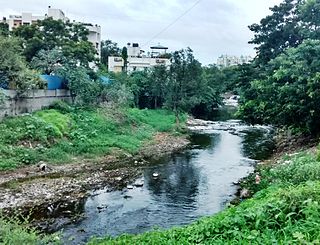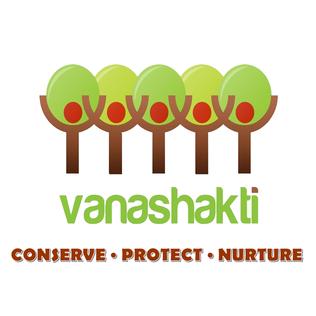
Arua District is a district in the Northern Region of Uganda. Like many Ugandan districts, it too shares its name with its administrative center of Arua. The name Arua is said to be derived from the Lugbara name for prison (Arujo) and prisoner (Aru), since the white settlers had a detention center at Arua Hill.

Yumbe District is a district in Northern Region, Uganda. Like most other Ugandan districts, it is named after its 'chief town', Yumbe, where the district headquarters are located.

Arua is a city and commercial centre within the Arua District in the Northern Region of Uganda.

A riparian buffer or stream buffer is a vegetated area near a stream, usually forested, which helps shade and partially protect the stream from the impact of adjacent land uses. It plays a key role in increasing water quality in associated streams, rivers, and lakes, thus providing environmental benefits. With the decline of many aquatic ecosystems due to agriculture, riparian buffers have become a very common conservation practice aimed at increasing water quality and reducing pollution.

The Ugandan water supply and sanitation sector made substantial progress in urban areas from the mid-1990s until at least 2006, with substantial increases in coverage as well as in operational and commercial performance. Sector reforms from 1998 to 2003 included the commercialization and modernization of the National Water and Sewerage Corporation (NWSC) operating in cities and larger towns, as well as decentralization and private sector participation in small towns.
Water resources management in modern Egypt is a complex process that involves multiple stakeholders who use water for irrigation, municipal and industrial water supply, hydropower generation and navigation. In addition, the waters of the Nile support aquatic ecosystems that are threatened by abstraction and pollution. Egypt also has substantial fossil groundwater resources in the Western Desert.
Akyatan Lagoon is a 14700-hectare wetland ecosystem that is designated as Wetland of International Importance by Ramsar Convention. A major stopover for migrating birds, Akyatan is recognized as an Important Bird Area by BirdLife International. It is the single largest green turtle rookery at the Mediterranean, holding 43% of the Mediterranean nesting population.

The Ramnadi is a river in Pune District and is a tributary of the Mula. It originates in the Sahyadris near Khatpewadi, north-west of Pune city. The river flows through the Bhugaon, Bhukum, Bavdhan, Pashan, Baner and Aundh areas of Pune city. It is defined as a brook by the Pune Municipal Corporation (PMC).
Tara is a subcounty at the north-eastern end of Maracha District of Uganda. It is an area endowed with rocks and is neighboured in the Northwest by Koboko; to the Northeast by Yumbe; to the East by Omugo subcounty plus to the South by Nyadri. Other subcounties in Maracha include Yivu, Aiivu, Oleba, Uriama, Omugo and Nyadri.
Agofe is the noble title for the chief cultural leader among all the Lugbara people or King of Lado Kingdom which covers the regions of West Nile, Ituri, Torit, Uele and Yei. The term means 'Pillar' or 'Paramount Chief' and was the title given to Jalusiga. A king is also called opi in Lugbara though an opi is usually a chief or the clan leader of a Lugbara lineage. Around 1967, President Milton Obote abolished kingdoms, but then the 1995 Uganda Constitution reinstated cultural institutions and by 2000, the Lugbara Cultural Institution had evolved. In 2015, the Government of Uganda finally accepted this revised Agofe institution among the 17 recognised cultural institutions in Uganda. The Agofe's duty is to preserve Lugbara culture through literature and other assignments.

Vanashakti is a non-profit environmental NGO based in Mumbai, Maharashtra. It was formed in 2006, by Meenakshi Menon, Namita Roy Ghose, and Peter Armand Menon. Vanashakti aims to conserve the forests, wetlands, wildlife corridors, habitats, through education and litigation to achieve its objectives of creating awareness about environmental topics, protecting and reviving rivers and preventing opencast mining in areas that are well-endowed with biodiversity. It also directs its efforts in involving local forest-dwelling communities to protect the biodiversity of the region and provides sustainable livelihood options for forest dependent and coastal communities. Vanashakti's thrust areas are forest, mangrove and wetland protection, environmental education for both urban and rural schools, livelihoods for forest based communities and scientific investigation into local environmental degradation.
The Karuma–Olwiyo–Pakwach–Nebbi–Arua Road is a road in the Northern Region of Uganda, connecting the towns of Karuma, Olwiyo, Pakwach, Nebbi and the city of Arua.

Central Tsernozemsky Nature Reserve is a Russian 'zapovednik' that protects for scientific study a collection of selected sites of black soil prairie in the southwestern part of the Central Uplands within the middle of the forest-steppe zone. The six sites of the reserve spread out to the southeast of the city of Kursk, in the Medvensky District, Manturovsky District, Gorshechensky District of Kursk Oblast. It covers an area of 5,287 ha (20.41 sq mi).

Rhino Camp Refugee Settlement is a refugee camp located in the districts of Madi-Okollo and Terego District in North Western Uganda.
Parombo is a town in the West Nile sub-region of the Northern Region of Uganda.
The Mbéré Valley National Park is a national park in eastern-central Cameroon.
The Lira–Gulu–Nebbi–Arua High Voltage Power Line is an operational high voltage electricity power line in Uganda. It connects the high voltage substation at Lira, in Lira District, to another high voltage substation at Arua, in Arua District, all in the Northern Region of the country.
Imvepi Refugee Settlement is a refugee camp in Terego District in West Nile Sub Region of northwestern Uganda.

Terego is a district in Uganda's Northern Region. It is located approximately 360 kilometres (220 mi) northwest of Uganda's capital Kampala. The administrative centre of the district is the trading centre of Leju in Aii-Vu Sub-County. Terego District covers an area of 1,102 square kilometres (425 sq mi) and the areas now making up the district recorded a non-refugee population of 199,303 in the 2014 Ugandan census. Terego District also hosts an estimated 168,000 refugees, mostly from South Sudan, in the Imvepi Refugee Settlement and the western zones of the Rhino Camp Refugee Settlement in the district.
Gulu Water Supply and Sanitation Project (GWSSP), also Gulu Water Supply and Sewerage System, is a water intake, purification, distribution and waste water collection and disposal system in the city of Gulu, the largest urban centre in the Northern Region of Uganda. In October 2020, the Uganda government concluded Phase 1 of the improvement of water supply and sanitation in the city, with funding from the World Bank, KfW and the Government of Uganda. Phase 2 improvements are expected to start in 2021, with funding from the World Bank, KfW and the Commonwealth Development Corporation.









